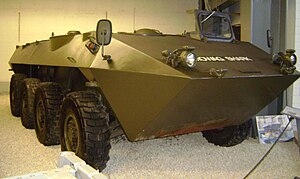MOWAG Shark
| MOWAG Shark | |
|---|---|
 MOWAG Shark at Military Museum Full | |
| Place of origin | |
| Service history | |
| Used by | no one |
| Production history | |
| Designer | MOWAG Motor Car Factory, Kreuzlingen, Switzerland |
| Manufacturer | MOWAG |
| Produced | 1981 |
| No. built | 3 |
| Variants | APC, Tank, AAA, Anti Tank. |
| Specifications | |
| Mass | 8x8:21,000 kg (46,000 lb) (loaded) 16,000 kg (35,000 lb) (empty) |
| Length | 7.52 m (296 in) |
| Width | 3 m (120 in) |
| Height | 1.9 m (75 in) |
| Crew | 3 or 4 |
Main armament | 105 mm gun or 35 mm cannon, twin 30 mm SPAAG or ADATS missile system |
Secondary armament | 7.62 mm machine gun |
| Engine | Detroit Diesel 8V-71T turbo-charged diesel developing 530 hp at 2500 rpm |
| Power/weight | POWER-TO-WEIGHT RATIO 25.2 hp/tonne |
| Payload capacity | 2,200kg (at protection level 2/2a) 6x6: 7,300kg |
| Transmission | Allison HT 750 ORD automatic with 5 forward and 1 reverse gears |
| Suspension | 8x8 wheeled, TYRES 13.00 x 20 run-flat (insert) |
| Ground clearance | .46m |
| Fuel capacity | 400 L (106 US gal; 88 imp gal) |
Operational range | 500 km (310 mi) |
| Maximum speed | 100 km/h (62 mph) |
Steering system | 1 and4 axel |
The MOWAG Shark is an armored personnel carriers produced by the MOWAG Motor Car Factory, Kreuzlingen, Switzerland.
MOWAG Shark Weapons Carrier
Development
The Shark has been developed by the MOWAG Company as a private venture specifically for the export market.It is one of many sorts of vehicles constructed by MOWAG. It was first shown in public at the 1981 Paris Air Show fitted with the Oerlikon-Bührle Type GDD-BOE two-man turret armed with a 35 mm cannon and a coaxial 7.62 mm machine gun. A further two prototypes were completed in mid-1983. In 1982 the Shark was successfully tested in Switzerland, fitted with a French Fives-Gail Babcock FL-12 turret armed with a 105 mm gun and fitted with a SOPTAC fire-control system. In West Germany it was successfully tested with an experimental Rheinmetall turret armed with the Rheinmetall 105 mm Rh 105-11 super low recoil gun which fires all standard NATO tank ammunition, including the APFSDS-T. The chassis has been designed to be easily adapted for a wide range of roles including anti-aircraft (eg fitted with the same turret as the Wildcat twin 30 mm SPAAG or the new Swiss ADATS missile system), anti-tank (including missile), fire support, reconnaissance and rocket launcher. Late in 1983 one of the three Shark prototypes was fitted with the one-man turret of the Wildcat twin 30 mm SPAAG system and this was tested in Canada early in 1984. Wherever possible proven assemblies, such as engine and transmission, have been used in the design of the vehicle to simplify both training and logistics. How ever the MOWAG Shark never went into production, as alternative to the MOWAG Shark MOWAG build the 10x10Piranha. One of the Shark prototypes is now part of the Military Museum Full in Switzerland.[1]
Description
The hull of the MOWAG Shark is of all-welded steel construction which provides complete protection up to and including the Soviet 14.5 mm KPV armor piercing round. A 155 mm HE projectile landing ten meters away from the vehicle will cause no damage according to the manufacturer. The driver is seated at the front of the hull on the left side and has a single-piece hatch cover that opens to the left. Forward of this are three periscopes, the centre one of which can be replaced by an image intensification periscope for driving at night. A second crew member can be seated to the right of the driver or this space can be used for special equipment such as an NBC pack or for additional ammunition stowage. The fighting compartment is in the centre of the vehicle and a wide range of armament installations can be fitted up to and including an FL-12 turret with a 105 mm gun. Full details of the FL-12 turret are given in the entry for the Austrian Steyr-Daimler-Puck Jagdpanzer SK 105 light tank/tank destroyer.[2] The engine, transmission and fuel tanks are at the rear of the hull and engine access panels are provided in the top of the engine compartment. The air inlet louvers are in the top of the hull, one either side, while the air outlets at the hull rear. Steering is power assisted on the front and rear axles and vertical suspension travel is 420 mm. A wide range of optional equipment can be fitted to the Shark including various types of NBC system, passive night vision equipment and fire-extinguishing systems.[1]
Specifications
- AXIS OF FIRE (105 mm gun) 2 16 m
- GROUND CLEARANCE 0.46 m
- TRACK 2.62 m
- WHEELBASE 1.51 m + 1.4 m + 1 49 m
- ANGLE OF APPROACH/DEPARTURE 40°/45°
- FORDING 1.3 m
- GRADIENT 60%
- SIDE SLOPE 35%
- VERTICAL OBSTACLE 0.46 m
- TRENCH 2.3 m
- TURNING CIRCLE 12.5 m
- SUSPENSION (1st and 4th axles) coil springs with wishbone (2nd and 3rd axles) torsion bars (all wheels have hydraulic shock absorbers)
- BRAKES (main) dual circuit, hydraulic, air assisted (parking) spring loaded brake cylinder (engine) Jacobs brake system
- ELECTRICAL SYSTEM 24 Volt
